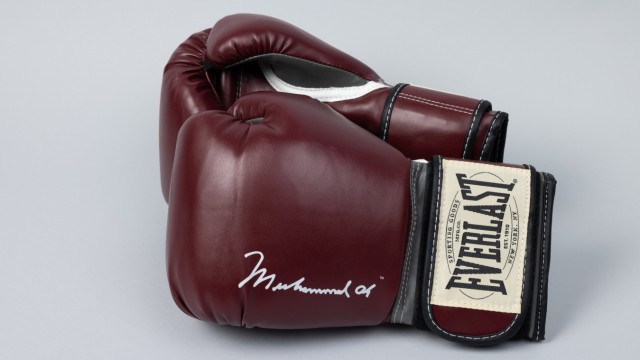He is short-tempered and rowdy. He repeatedly goes into a frenzy, sometimes goes crazy and even becomes a murderer. Heracles, a moral role model? Well, from today’s perspective, definitely not. The Greek demigod is characterized by other qualities that have long made him the prototype of a hero. Just like he is in superhuman size Rosenheim locomotive shed Leaning on his club, Heracles definitely seems at peace with himself. As a “god for all occasions” he inspires admiration with his muscular ideal body. And they want to be admired, the heroes, don’t they? In the exhibition “Heroines & Heroes“In any case, there are plenty of them in the engine shed. There is an extensive course through the hero’s story.
Well over 100 “role models and idols from antiquity to today,” as the subtitle states, are presented in the engine shed. 351 exhibits are on display, including 192 originals. There are also 69 media stations, 28 of which are interactive and can be linked to a smartphone. There you can go on your own hero’s journey virtually using a QR code, in the form of a role-playing game including an avatar. The adventures to be had? Mostly small games of skill, no major heroic deeds, but you learn a lot about heroes, their opponents and the most important stages of a hero’s journey. This is also what the exhibition itself teaches you, which is not structured chronologically, but rather conveys all the important facets of heroism thematically.
As far as the heroes selected are concerned, the approach is extremely broad. This ranges from comic superheroes and athletes to scientists and politicians to environmental activists and the “everyday heroes” celebrated during the corona pandemic. According to the manager of the engine shed, Jennifer Morscheiser, the latter also provided the impetus for the exhibition. Together with the superheroes who have been flooding into the cinemas for years. Inspired by this, the historians Andrea Erkenbrecher and Thomas Forstner, as a curator duo, set out to find an answer to the question of what makes a hero a hero. But despite the many examples and findings: there is no clear answer. And that very consciously.
Instead, you learn that the hero question depends on the time, the context and the respective society. That means: Every time, every society has its own heroines and heroes. And in the end, each of us probably sees something different than heroic. This can be a sporting or other physical peak performance like that of Steffi Graf, Muhammad Ali or the polar explorer Ernest Shackelton. Political resistance such as that offered by Sophie Scholl and Claus Schenk Graf von Stauffenberg against the Nazis or by Alexei Navalny against Vladimir Putin. Or an outstanding scientific achievement like that of the two-time Nobel Prize winner Marie Curie, who died as a result of her research.
The true-to-original replica of the Batmobile from Tim Burton’s Batman films is life-sized.
(Photo: Axel Jusseit)
Many heroines and heroes risk their lives for a greater cause. And often they show us what is humanly possible. But it can also be intimidating. That’s why there are anti-heroes as “relief”, of which Mr. Bean, Forrest Gump and the Dude from “The Big Lebowski” are presented in film examples. Also the unusual comic characters “Dragman”, “Trachtman” and “Ladybug” don’t quite correspond to the classic hero ideal. And don’t heroes like Achilles and Siegfried from the Nibelungen saga also have their Achilles’ heel? The fact that the German reception of the Nibelungen has dark spots is also discussed in the exhibition. Just like that changed status of war heroes.

Every hero needs the right weapon – in the case of Muhammad Ali, these are his signed Everlast boxing gloves.
(Photo: Bokeum Lee/LWL Museums for Industrial Culture. Westphalian State Museum)
Equal opponents and temptations are also needed for a “hero’s journey”. And, according to the American myth researcher Joseph Campbell, also a mentor. As far as the opponents are concerned, there are Darth Vader and two Stormtroopers from “Star Wars” in a mixed media drawing, a picture postcard of Siegfried fighting the dragon or Joker and Riddler from “Batman” as life-size figures. The true-to-original Batmobile from Tim Burton’s Batman films and the statues of Din Djarin and Baby Yoda from the Star Wars series “The Mandalorian” are also life-sized. The boxing gloves signed by Muhammad Ali or Luke Skywalker’s lightsaber as an original film prop show that a hero also needs the right weapon.
How to remember and properly honor heroes is also an important question. It is explored using a bust of Sophie Scholl, a replica of an original 3D sculpture by Nelson Mandela, the graffiti “Super Nurse” by Uzey, autograph cards, stamps, T-shirts, comics, drinks cans or a shower gel. And the further question is asked as to whether the whole thing represents an inflation of the possibly devalued concept of hero or, on the contrary, its democratization.
The works by photography students from Hanover at the end of the exhibition prove that food rescuers can be perceived as heroic in the same way as an Afghan drag queen. And in the end, isn’t it the case that in the right situation, with the right opportunity, each and every one of us can become a heroine, a hero? The exhibition provides more than enough suggestions for such questions. The same applies to the accompanying volume, which is well worth reading and deepens the content, and the supporting program with 60 events. These include concerts, lectures and a three-day “Fantasy Reading Festival” in September.
Heroines & Heroes, until December 15th, Lokschuppen Rosenheim, Rathausstraße 24, www.lokschuppen.de

